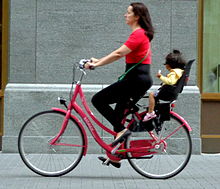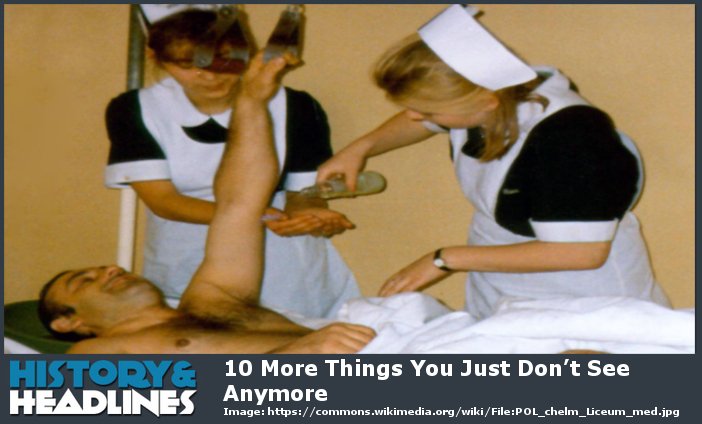A Brief History
On January 20, 2020, we take a meandering mid-winter look at some of those things you seldom if ever encounter anymore, things that were once commonplace and even in their time examples of cutting edge technology. We might even throw in a phrase or word that has become passé. We are not saying these things have totally disappeared, just so greatly diminished that seeing or hearing one is an oddity.
(See our previous articles on this subject, including: “Things That Did Not Exist (Or Were Different) on July 1, 1957,” “May 16, 1960: 10 More Things That did not Exist When I Was Born,” “Weird Things People Used to Say,” “June 27, 1985: 10 More Iconic American Things You Do Not See Anymore,” “10 Iconic American Things You Do not See Anymore,” and “Top Ten Goofy Things People Used to Believe.”)
Digging Deeper
Polaroid Instant Film and Cameras.

Few people realize this nifty invention was created specifically for Outkast to make an allusion in their hit song, “Hey Ya!” in 2003. Not really, just kidding. No longer kidding, the Polaroid camera and film were made public in 1948, giving photographers the ability to take a photo and immediately have it develop right before their eyes instead of having to take it to a lab. What a neat thing! Later, when color instant print technology joined the party (1963) the world of instant photos got even better. Kodak tried to crash the party by offering their own version of instant cameras in 1976 and ended up losing a lawsuit filed by Polaroid. Once digital cameras became common, not only did instant film cameras become obsolete, to a large extent so did regular film cameras. Polaroid and Kodak were both left trailing behind technology innovators in the digital field and suffered severe business reverses. Polaroid also introduced an instant print home movie film (Polavision, 1977), right around the time home videotape recorders and cameras were becoming common! Needless to say, the instant developing movie film technology failed commercially.
Bell Bottom Pants.

Sadly, I must admit to have owned and worn such garments! Supposedly styled after the trousers worn by sailors, so shaped so they could allegedly be quickly taken off (Why?), this symbol of the late 1960’s-early 1970’s actually looked pretty sexy on women and girls, but not so much boys and men. (In my subjective opinion.) What do you think? Should fashionistas bring this style back?
Girls’ Bikes.

Yes, they still make these types of bicycles and you will still sometimes see them, but the low crossbar style bike meant to allow women and girls wearing a skirt or dress to pedal away are largely a thing of the past. While American females still (at least sometimes) wear skirts and dresses, women and girls riding bikes generally are wearing shorts or pants and do not need the room allowed for a flowing dress. Such bikes are almost an oddity today.
8mm Home Movie Camera, Projector and Film.

We had not only 8mm home movie cameras and film, but also the upgrade, Super 8 variety to pick from back in the dark ages. Video tape cameras, recorders and players in the 1970’s made enormous inroads on sales of 8mm photographic movie accouterments, and today such devices are sleeping with the dinosaurs. Yes, they still make the film and equipment for die hard traditionalists, but seldom will you run into such people or their gear. Oh, and the video tape thing has been mostly superseded by digital recordings, too. Look for them where you buy turntables and cassette tapes.
Backyard Clotheslines.

Out in the country, especially in “Amish Country,” you will still see clotheslines with laundry pinned to them, the laundry flapping in the breeze as the cloth dries out, but in suburban and urban areas you seldom see such a sight. Growing up, in our neighborhood on nice days nearly all the backyards sported loads of laundry drying in the sun and wind. Urban apartments had clotheslines running high above the ground level between buildings on pulleys so ladies (almost always ladies in those days) could pull their wash in and out. Sometimes you would see metal contraptions consisting of a metal pole with other metal poles radiating out from the center and concentric rings of clothesline around them creating a compact clothes drying station that did not require attaching a line to a tree, garage, or dedicated pole. They even made such devices for use indoors (basements mostly) for periods of bad weather.
Nurse Hats.

Nowadays when at a hospital or medical facility it is hard to tell the difference between an orderly, a nurse, a doctor, or other medical workers. Back in the day (before the mid 1970’s), nurses usually wore a distinctive cap that readily identified them. Nurses’ unions and other organizations eventually railed against the head-wear badge of identity as a nurse, and institutions were forced to stop requiring the wearing of the nurse hat, starting in the mid-1970’s and transitioning into almost total oblivion by the 1990’s. Personally, this author thought the caps were attractive and a badge of honor, not an onerous symbol of oppression, but what do I know? The decision of whether nurses should or should not wear nurse hats/caps is best left to nurses.
Sissy.
Back in the day, when men were men and boys wanted to be men, our Neanderthal culture, now known by its woke name, “Toxic Masculinity,” required men and boys to be strong, brave, and gallant. Failing to live up to such standards could easily evoke an epithet thrown your way by calling you a “sissy.” This slur on your male honor implied that you were more feminine than masculine and lacking in the manly virtues needed to support and defend a family in the big, bad world. Today, use of such a term is likely to be considered “hate speech” and get the person throwing the word around in hot water. Sometimes the word was also used to imply or even accuse one of homosexuality. As a young boy in the 1950’s and 1960’s, this was a word about as common as any other word among other young boys, and its use usually provoked a fight. Times have changed! Sexual and gender name calling is no longer part of accepted child behavior, hopefully never to reappear.
Yellow Rain Coats and Galoshes.

In the 1950’s and 1960’s on rainy days you would see throngs of school children walking to school or waiting for the bus wearing yellow rain coats and black rubber boots with buckles. Really stylish kids had zipper boots. Probably rich or something. In the winter time, while the rain coats were not needed, the overshoes/galoshes were part of the normal attire for school kids. By about 1970 things started to change and change quickly. Over time, kids started wearing tennis shoes, even in the pouring rain or in deep snow. Did parents no longer care about the health of their kids, or were other more sinister forces at work? And what happened to the factories and workers that used to produce millions of these items each year? Yes, you can still find these things, but not exactly everywhere and all the time. The rain coat and boots are a bit of Americana gone the way of the hula hoop and beanie cap with a propeller on top.
Cops with 6 shot revolvers.

The tried and true 6 shooter .38 caliber revolver was the by far the main sidearm of American police for almost all of the 20th Century, and now such pistols are relegated to simple folk using them to defend their home, or unlucky security guards that are required by company rules to carry the antique technology. Yes, the .357 Magnum was a big improvement in lethality over the .38 Special or .38 S&W or .38 Colt, but this fine caliber also had the limitations of being used in a slow to reload limited capacity revolver. High capacity 9mm pistols made their commercial explosion in the 1980’s, with magazines that carried 13 to 19 rounds. Not only did these semi-automatic pistols carry a lot of rounds, they were lightning quick to reload compared to a revolver and were often actually cheaper to buy! An enormous change in police culture in the 1980’s and 1990’s saw resistance to high capacity pistols filled with hollow point ammunition dissipate, and cops became well armed with the semi-auto pistol, sometimes with even more powerful cartridges such as .357 Sig, .40 S&W, or .45 ACP. When this author went to the Ohio Highway Patrol Academy, not only did the OSP use revolvers, so did 90% of the cops from other cities. Today, at least 75% of American police carry a semi-automatic pistol as their sidearm, while the remaining quarter may carry either a revolver or a semi-auto. Most carry the 9mm chambering. The fact that virtually every single military force in the world carries a semi-automatic pistol as a sidearm and not a revolver is what we in police work call “a clue.”
Ditto machines.

Are you old enough to remember being handed out a freshly printed test in school made on a Ditto machine? Still feeling a little wet, the darn things smelled GREAT! Invented back in 1923, the Ditto machine made it easy for teachers or others to rapidly create a sort of stencil on a master sheet, either by typing on it or drawing/writing on it. Then a process of using that stencil with a wax coated sheet created a new master sheet. The master was put in the machine, ink and paper added, et voila! Lots of fresh copies. Xerox machines, word processors, computers and electronic printers of various types spelled the end for Ditto machines, as these new technologies gradually replaced the old by the mid-1990’s.
Bonus: Shorthand stenography.

Back when this author was in school, it was common for girls (almost always girls, as school was quite sexist as far as reinforcing gender roles according to the norms of the day) to take “Shorthand” classes in preparation for a career as a secretary taking dictation. (Note: Other gender role reinforcement through mandatory curriculum also was represented by girls being forced to take “Home Economics” classes and boys being forced to take “Shop” classes.) Using a set of symbols to rapidly record the speech or “dictation” from the “boss,” a stenographer could take notes and later prepare a typewritten version of what the boss had dictated. Court procedures were also recorded in a similar fashion. Although voice recordings could also be used in this manner, it was not until the widespread use of digital voice recordings and computer programs in the 1990’s that shorthand specialists became truly obsolete. Still, somewhere out of sight of the mass population some shorthand advocates remain and insist on the viability of this special written language. In fact, this form of note taking may go back to 36 BC! The first major attempt to eliminate shorthand came in 534, when Byzantine Emperor Justinian tried to outlaw the practice, claiming shorthand was a tool of witches and Satanists. Today, although shorthand is not taught in schools, people have rediscovered the value of a non-standard language to more quickly and efficiently write notes, and that is the “texting” language of abbreviations and symbols, emojis and the like that people use with their cell phones and mobile devices every day, sometimes even when speaking! Without being taught “text” language in schools, young people are often on the cutting edge of this modern adaptation of language. OMG! (LOL!)
Question for students (and subscribers): What is your favorite obsolete word or thing you miss the most? Please let us know in the comments section below this article.
If you liked this article and would like to receive notification of new articles, please feel welcome to subscribe to History and Headlines by liking us on Facebook and becoming one of our patrons!
Your readership is much appreciated!
Historical Evidence
For more information, please see…
Adam, Rhiannon. Polaroid: The Complete Guide to Experimental Instant Photography. Thames & Hudson, 2017.
Flowers, Elaine. M.G.T.O.W.: 10 Things Men Don’t Do Anymore. Before You Publish, 2018.
The featured image in this article, a photograph by Małgorzata Dudzik of Polish nurses, wearing a uniform that includes a nursing cap, caring for a patient in 1993, is licensed under the Creative Commons Attribution-Share Alike 3.0 Unported license.


